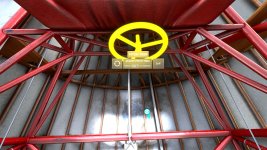I still have yet to spend all that much time flying the new Gee Bee Model Z in MSFS, but I noticed that the handling seems to be quite the same or identical to that of the Carenado Gee Bee R-2, but just that it accurately stalls about 20 mph slower than the R-2. The feel of these flight models is more in-line with how the Gee Bee Model Z flies, compared to the Gee Bee R-2 (which, according to Delmar, flies like no other aircraft). Where as Delmar described the Gee Bee R-2 as having extremely sensitive control behavior in pitch/roll/yaw, being
four times more sensitive than a Pitts Special, the Gee Bee Model Z on the other hand, which is a completely different and earlier design, and with the center of gravity positioned farther forward, the in-flight control behavior is much more stiff, and requires as much as 50% more control force in pitch/roll than the Gee Bee R-2.
Some descriptions from Delmar Benjamin on flying the Gee Bee R-2 in an article from 1998 (
https://www.avweb.com/air-shows-even...d-for-speed/):
"First I bring the power up and I use all of it, it really goes nice and straight. You got the stick forward and you’re waiting for the tail to come up, because you can’t see anything until the tail comes up. And you get the tail up and then you can see down the runway, you need to hold it on until 120 (mph), because it’s got aileron reversal. If you dial in an angle of attack around 100 it would fly off, but the ailerons would be reversed at that speed, so if you move the ailerons you would snap in."
“You fly with kid gloves…it’s a very light touch. It doesn’t have any stick pressure and sometimes it uses negative pressure. But once I got accustomed to that, I liked the way it flies. The rudder is 13 inches deep and 6 feet tall,very large when you look at it…and it’ll beat you to death. You hit the rudder and your head hits and canopy. See, the canopy’s pretty scarred up there, I always seem to hit my headset on the left side for some reason.”
“It’s so pitch sensitive that you could put one finger on top of the stick and you could break the wings off the airplane, just by pulling the stick back with one finger. That’s how sensitive it is. Like yesterday, I pulled for the barrel roll, and pulled about 10 g’s just because that thing is so pitch sensitive.”
“On landing, you need to keep speed up so you don’t get into aileron reversal, and you need to see the runway,so usually when I’m downwind, when I cross the numbers I start a turn and come right down to the runway and level out and touchdown and try to touch down easy because the shock absorbers on this thing don’t work well, and it’ll tear the gear off the airplane.Then your elevators quit working at about 80 mph, so the tail will come down on its own at about 80-100 mph and that is too fast to be going down the runway and you can’t see anything in front of you. And there’s so many curved surfaces you can’t lookout one side and tell if you’re straight, so you try to put your head back against the headrest and you try to keep the same amount of runway on both sides–you can only see a little pie shape of runway behind the wings and you try to keep the same amount.” (He doesn't explain it here, but you can tell in the videos and it was explained in his aerobatic performances that he always made ample use of the toe brakes on landing, which kept the tail up and the airplane slowing down faster, until he would come nearly to a stop on the runway so that he was in complete control of the aircraft before taxiing off the runway.)
The effect of the ailerons on the Gee Bee R-2 reverses when the aircraft gets down to 110 mph (which is still about 15 mph above its stall speed). On Delmar's third test flight in the aircraft, not yet aware of that phenomena, he tried a slower, three-point attitude landing, and the ailerons reversed at 110 mph and it snap rolled just above the ground, causing the right aileron to strike the ground, but Delmar was otherwise able to recover it (the scuff marks/minor damage to the right aileron was never repaired, so as to serve as a reminder to how close he had come in that instance). After that, every landing was made with a minimum 120 mph airspeed at touchdown.
Delmar's aerobatic routine of course would have the aircraft flying at quite a good clip, somewhere in the 200s (mph). The fastest Delmar ever flew the R-2 was at Reno in 1992, where it is said that he approached nearly 300 mph on the airspeed indicator.



